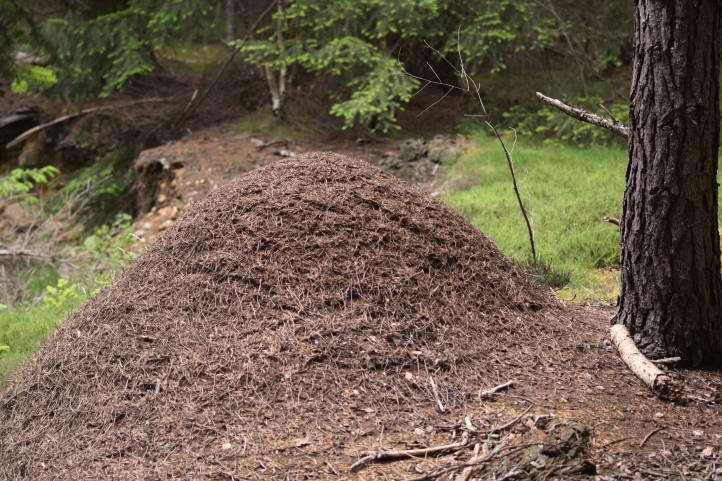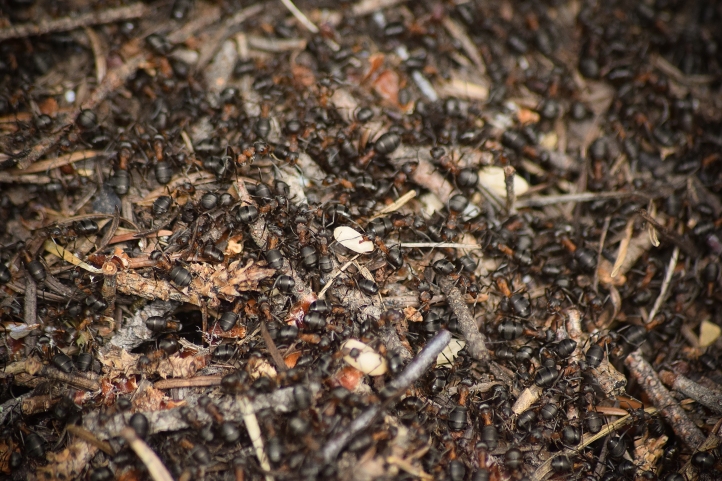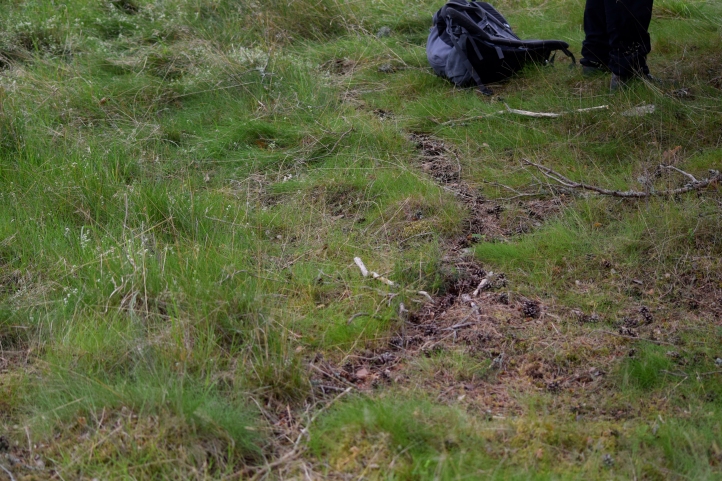I spent last Saturday surveying wood ants along with a few other John Muir Trust volunteers. It was a gorgeous sunny day in a lovely part of Glen Tanar estate (within the Cairngorm National Park.) There are four true species of wood ants in the UK, two of which are found in Scotland – the Scottish wood ant (Formica aquilonia) and the Hairy wood ant (Formica lugubrious.) Our day consisted of taking grid references at each mound and recording which species it belonged to.

The thatched mounds constructed by the ants are impressive structures – some were around 1.5m tall and likely very old. The nests also extend well underground and are divided into different chambers containing food, broods and the queen. The mounds are usually found in well drained coniferous woodland and are south facing to catch the sun. What you see above ground acts like a solar panel and is constructed in such a way that it maintains the correct temperature for raising the brood. On sunny days the ants can even be seen moving around their egg cases to warm them up. The outer surface of the mound is likewise arranged very specifically, allowing rainwater to run off without soaking the nest.

The surface of the mounds are a frenzy of wood ants all busy performing their specific roles, such as defence and setting out to forage. Close inspection of nearby trees reveals scores of ants going up and down to collect other small insects and honeydew from the aphids they farm. In some places, trails of ants walking to and from the mounds have even worn paths into the grass over the years!

Wood ant mounds are also home to many other specialist invertebrates such as this stunning rose chafer beetle. Its larvae live and feed on plant material inside the nest. As you can see the ants weren’t too pleased about this visitor, but thankfully the beetle is well armoured!

Scottish wood ants and hairy wood ants look incredibly similar. Identification involved holding an ant carefully between thumb and finger, and using a hand lens to view the amount of hairs on its thorax. Understandably, the hairy wood ant has a lot more hairs than the Scottish wood ant! When a hand is placed near the mound, the ants are highly alert and quick to inspect it. They will spray formic acid and bite, but thankfully this is not painful (unless as I learnt, in a specific location beneath the fingernail!)

Wood ants and their mounds are certainly fascinating and I would encourage you to go check them out for yourself! Watching them is quite hypnotic and I’m sure many hours could be spent observing their comings and goings. Wood ants are unfortunately threatened by deforestation and very sensitive to changes in woodland management. They are a keystone species, providing important services within their ecosystem and food for many other species. Thus we must seek to protect both them and the habitats where they are found.
Hi, a great way to spend a day. Just wondering, did you find nests of both species and can you tell the species from the mound size or do you have to study the individual ant? I remember reading somewhere that F. lugubris have smaller inter-connecting nests. We have a well established nest locally and it is nowhere near the size of the one I saw in the Highlands a few years back which I believe was the Scottish wood Ant. Thanks, an enjoyable read.
LikeLiked by 1 person
Hi there 🙂 I’m so sorry for not replying to this – for some reason I have stopped receiving comment notifications!
We found many many Scottish wood ant nests (some of which were surrounded by smaller “satellite” nests) and only one hairy wood ant nest which was completely on its own. The mounds of both species are the same in terms of the number and sizes they can reach so studying the ants is necessary.
However when we first saw the nest of hairy wood ants I instantly felt like they were different. Although the colour/patterning was identical the ants just seemed much bigger than all the scottish ones we had done earlier in the day. And they definitely had the more painful bite!
Some of the really big nests have been established for decades so you could just have a younger nest or perhaps its population has reached its maximum size in relation to the available food/building resources.
Best wishes
Apithanny
LikeLike
Thanks for the reply, interesting stuff. I aim to visit the local nest again soon before the weather turns, hopefully find a network as the nest I saw was possibly a smaller satellite. Fascinating creatures. All the best.
Alan M
LikeLiked by 1 person
good luck hope you find some more nests!
LikeLiked by 1 person